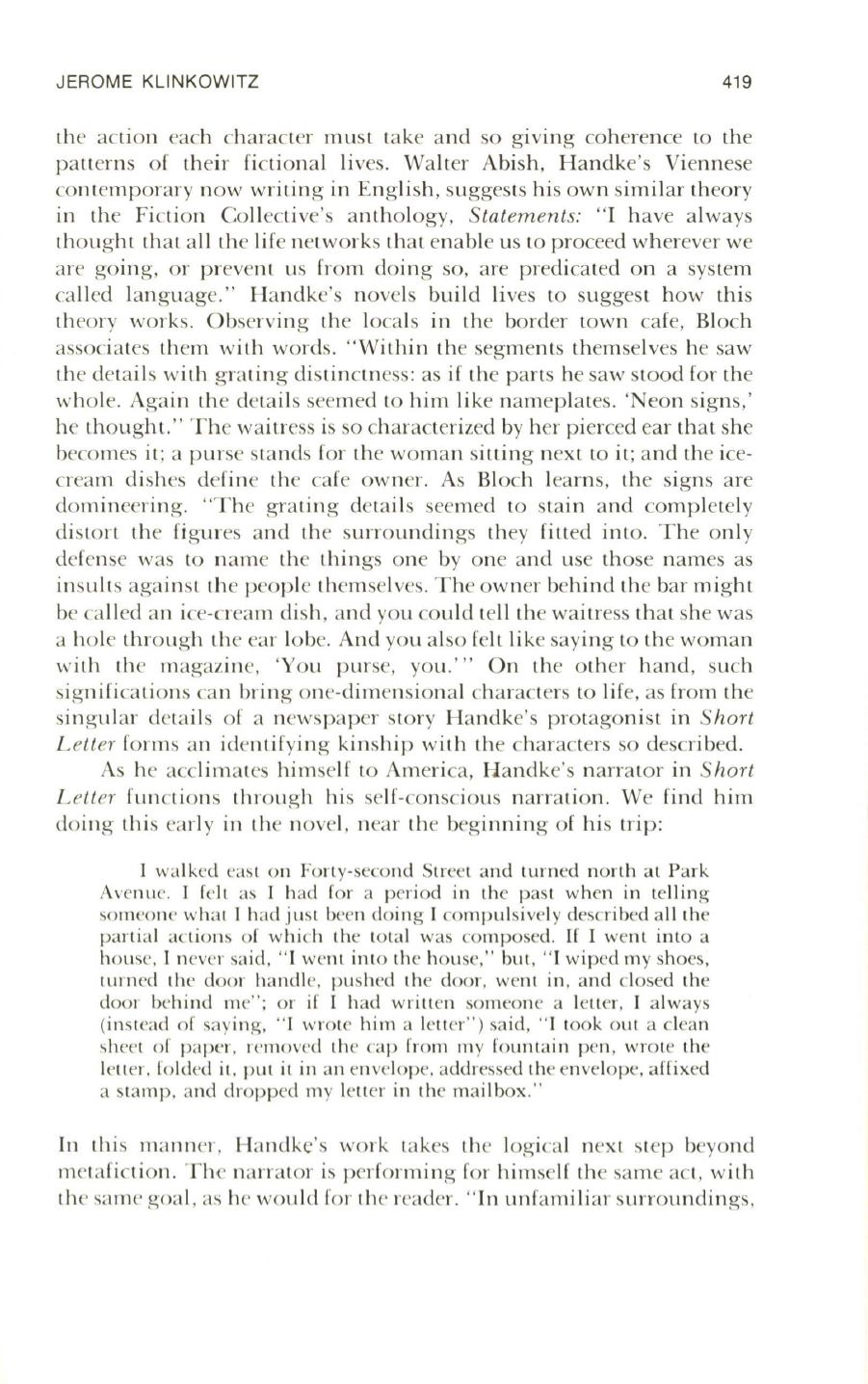
JEROME KLiNKOWITZ
419
the acti on each character must ta ke and so giving coherence to the
pa tterns of their fi ctiona l lives. Wa lter Abish , Handke's Vi ennese
contempo rary now writin g in En glish , sugges ts hi s own simil ar theory
in th e Fi cti on Coll ective's anthology,
S tatemen ts:
" I have a lways
tho ught tha t a ll the life networks tha t enable us to proceed wherever we
are go in g, o r prevent us from do ing so, are predi ca ted on a sys tem
ca ll ed language ." Hand ke's novels build li ves
to
sugges t how this
theory work s. Observin g the locals in the bo rder town cafe, Bloch
associa tes them with words. "Within the segments themselves he saw
the de ta il s with g rating di stinctness: as if the parts he saw stood for the
who le. Aga in the de tai ls seemed to him like namepl a tes . 'Neon signs,'
he tho ught. " The wa itress is so characteri zed by her pierced ear tha t she
becomes it; a purse stands for the woman sitting next to it; a nd the ice–
cream di shes defin e the cafe owner. As Bl och learn s, the signs a re
dom ineerin g. "The gra tin g deta il s seemed to sta in and compl etely
d isto rt the fi gures and th e surro undin gs they fitted into . The onl y
defense was to name the things one by one and use those names as
in sults aga inst the peopl e themselves . T he owner behind the bar might
be ca ll ed an ice-cream di sh , and you could tell the wa itress tha t she was
a ho le thro ugh the ear lo be. And you a lso felt like saying to the woman
with th e magaz ine, 'Yo u purse, you. '" On the o ther h and , such
sign ifi ca ti o ns can bring one-dimensional characters to life, as from the
sin gul ar deta il s of a newspaper story Handke's protagonist in
S hort
Lett er
forms an identifying kinshi p w ith the characters so described .
As he acclima tes himse lf
to
Ameri ca, Handke's narra to r in
S hort
L etter
[uncti ons through hi s se lf-conscio us narra ti on . We find him
do ing thi s ea rl y in the novel, near the beginning of hi s tri p:
I walked eas t on Forty-second Street and turned north a t Park
Avenue. I fell as I h ad for a peri od in the past when in telling
someon e wha t I had just been doing I comp ul sively described all the
parti al acti on s o f whi ch the LOtal was composed .
If
I weill illlo a
house, I never sa id, HI WCIll into the ho use," but, HI wiped my shoes,
turned th c door handl e, p ushed the door, weill in , and closed the
door behind me"; or if I had wrillen someone a leller, I always
(instead of say ing, HI wrote him a leller") sa id, HI took out a clean
sheet of paper, removed th e cap from my fountain pen , wrote the
leller, folded it, p ut it in an en velope, addressed the envelope, a ffixed
a stam p, and dropped my leller in the mailbox."
In thi s manner, Handke's work ta kes the logical next step beyond
meta fi cti on . T he narra to r is perfo rming for himself the same ac t, with
the same goa l, as he would fo r the reader . " In unfamili a r surroundings,


